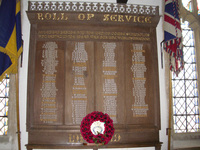- County name: Somerset
- Group/School name: Combe St Nicholas CE VA Primary School
- Age group: 5 - 11
- Group type: Key stage 2
Following an article in the February 2018 issue of the Bulletin, War Memorials Trust received an enquiry from a War Memorials Trust member who is also a governor of a primary school in Somerset. The school is located next to the village church which is home to a number of World War I war memorials and a Second World War memorial. The school chooses a theme for learning each year and Remembrance was selected for 2018-19. Each child in the school will produce individual pieces of work including pictures, poems and these will form a book which will be bound. Alongside the theme of Remembrance the older children’s topic during the autumn is the Second World War. The visit from War Memorials Trust would give key stage 2 pupils an opportunity to find out more about the importance of war memorials and allow upper key stage 2 the opportunity to research those named on the war memorials.
Our Learning Officer spent a very enjoyable morning at Combe St Nicholas C of E Primary School. The first session was spent with year 5 and 6 pupils. The session with them was split in half so that they had the opportunity to find out more about what war memorials are and why they are important before using the Commonwealth War Graves Commission ‘Find War Dead’ database to find out more about the fallen who are commemorated on the war memorials in the St Nicholas Church. One of the First World War memorials in the church is a frame which includes the photographs of the men from Combe St Nicholas who fell in the Great War. Alongside the research, these photographs enable the pupils to see the men as more than just a name.
Whilst discussing the importance of war memorials and why there was a wave of memorialisation following the end of the First World War, pupils were shown some local war memorials, many of which they were familiar with. Many were quite aware of the fact that the bodies of the fallen were not brought home but instead buried near the battlefields which helped them to understand why communities created war memorials.
The year 5 and 6 pupils showed huge amounts of enthusiasm when they began to research the names of the fallen from the First and Second World Wars. They really enjoyed finding out more about the men and were particularly intrigued by their ages. Many pupils identified that one of the men on the First World War memorial, H Hurford, signed up with the New Zealand Army but his parents lived at Beetham Farm in Combe St Nicholas. The school governor who has researched the fallen from the First World War was able to share that H Hurford was one of three brothers. He and one brother had emigrated to New Zealand and the third brother had emigrated to Australia. All three brothers signed up with the armed forces in their new homes.
Following the session, the class teacher decided to take the year 5 and 6 pupils to the church so they could explore the war memorials there in more detail. Pupils will also be given the opportunity in the coming days to continue their research as they would like to find out more and delve a little deeper than they were able to in the time they had.
The session after break time saw WMT’s Learning Officer working with pupils in year 3 and 4. The session began with a discussion about what a war memorial is and this included the different types of war memorials. Local examples were used to highlight the variety further as well as the fact that some war memorials are dedicated to those who served in earlier conflicts such as the Boer War. Pupils then found out how many war memorials there are in the UK and when most of these were created.
Using war memorial inscriptions pupils were asked to consider why so many war memorials were created in the wake of World War I. To highlight that the fallen were buried “Not here but faraway” pupils were shown the CWGC cemeteries where two Combe St Nicholas men were buried. T Furber was buried at Gaza War Cemetery in Israel and Palestine, and W Grabham was buried at Alexandra (Hadra) War Memorial Cemetery in Egypt. It was explained that families were unlikely to be able to visit these cemeteries and therefore a war memorial was a place locally where they could go and remember their loved one.
The final element of the session was to consider some of the problems facing war memorials. A local war memorial which had received a grant from War Memorials Trust towards cleaning was used as an example. Prior to the cleaning the names were almost illegible because of the layer of dirt and pollution which had formed on the memorial.
It was wonderful to work with such interested and enthusiastic pupils and staff at Combe St Nicholas. It is hoped that the visit has supported and enhanced the work that is being done on the theme of Remembrance and that they are able to view the war memorials in their church with greater understanding.





